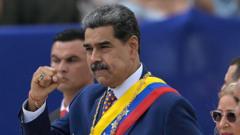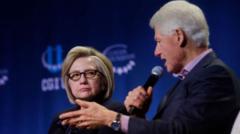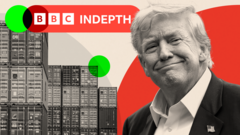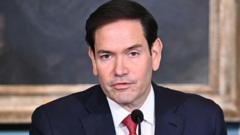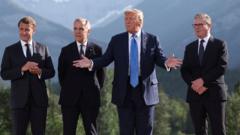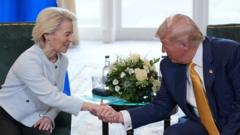In a recent report, the World Trade Organization (WTO) has issued a dire warning about the future of global trade, suggesting it is poised to shrink due to the ongoing tariffs imposed by the United States under President Donald Trump. During a press briefing in Geneva, WTO Director-General Ngozi Okonjo-Iweala emphasized the worrying state of US-China relations and the broader implications for the world economy.
Global Trade Faces Decline Due to US Tariffs, Warns WTO
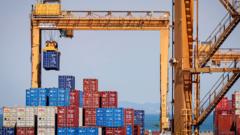
Global Trade Faces Decline Due to US Tariffs, Warns WTO
The World Trade Organization highlights the impact of US tariffs on international trade dynamics, forecasting potential declines.
The WTO has revised its earlier forecasts, predicting a contraction in global goods trade this year, primarily driven by tariffs and political tensions. The organization anticipates that trade in North America could decline by more than 10%, as tariffs create significant challenges. The previously expected growth of 2.7% for global goods trade by 2025 is now being adjusted to a decrease of 0.2%, raising alarms about possible recessions in affected regions.
Chief Economist Ralph Ossa underscored the unpredictability associated with tariff implementation, noting that such policies can lead to unforeseen negative consequences, including reduced exports and overall economic slowdown. This sentiment was reinforced by the United Nations Conference on Trade and Development (UNCTAD), which has projected a slowdown in global growth due to trade tensions, now estimating a mere 2.3% growth for 2025, below the threshold that suggests a global recession.
The enforcement of a baseline tariff of 10% on most foreign imports to the US has had immediate impacts, causing a decline in the US stock market amidst growing uncertainty. However, some regions such as Asia and Europe still show potential for trade growth, despite the setbacks experienced by North America. The WTO's report also marked its initial forecast for services trade, expecting a 4% growth in this sector by 2025, illustrating a shift in trade dynamics.
As the Trump administration continues to maneuver tariffs and trade policies, critics argue that the strategy of reshoring manufacturing to the US is fraught with complexity and protracted timelines, complicating the nation's economic outlook. Despite market opposition, Trump briefly paused tariffs on various nations except China earlier this month, reflecting the challenges faced in maintaining a coherent trade strategy while balancing political pressures.
As the global economy navigates through these tumultuous waters, the repercussions of tariff implementations and political decisions remain a key focus for international observers and analysts alike.
Chief Economist Ralph Ossa underscored the unpredictability associated with tariff implementation, noting that such policies can lead to unforeseen negative consequences, including reduced exports and overall economic slowdown. This sentiment was reinforced by the United Nations Conference on Trade and Development (UNCTAD), which has projected a slowdown in global growth due to trade tensions, now estimating a mere 2.3% growth for 2025, below the threshold that suggests a global recession.
The enforcement of a baseline tariff of 10% on most foreign imports to the US has had immediate impacts, causing a decline in the US stock market amidst growing uncertainty. However, some regions such as Asia and Europe still show potential for trade growth, despite the setbacks experienced by North America. The WTO's report also marked its initial forecast for services trade, expecting a 4% growth in this sector by 2025, illustrating a shift in trade dynamics.
As the Trump administration continues to maneuver tariffs and trade policies, critics argue that the strategy of reshoring manufacturing to the US is fraught with complexity and protracted timelines, complicating the nation's economic outlook. Despite market opposition, Trump briefly paused tariffs on various nations except China earlier this month, reflecting the challenges faced in maintaining a coherent trade strategy while balancing political pressures.
As the global economy navigates through these tumultuous waters, the repercussions of tariff implementations and political decisions remain a key focus for international observers and analysts alike.


